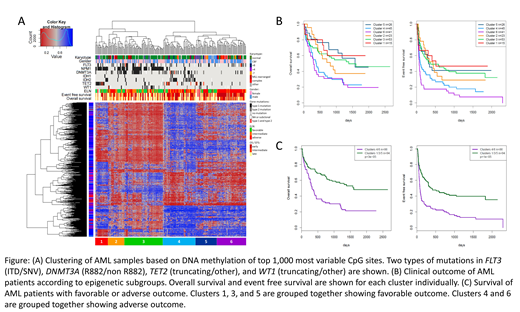In acute myeloid leukemia (AML), DNA methylation is frequently altered and epigenetic regulators are commonly mutated. Here, we describe the effects of mutations in commonly mutated genes (NPM1, FLT3-ITD, DNMT3A, IDH1, IDH2, TET2, and WT1), including epigenetic regulators, on DNA methylation profiles and differential gene expression. Moreover, we show that subgroups of epigenetically homogeneous AML patients differ significantly in clinical outcome.
We have characterized 212 AML patients treated on consecutive trials of the AMLCG study group using Illumina Infinium MethylationEPIC BeadChips, gene panel sequencing, and transcriptome sequencing. In order to detect differentially methylated CpG sites (dmCpGs) according to a particular mutation, we have selected sets of mutated and control samples for each gene of interest individually. We excluded samples with subclonal variants only and selected control samples based on matching karyotype and matching pattern of co-mutations.
Mutations at the R882 hotspot of DNMT3A result in global hypomethylation while alterations of IDH1, IDH2, TET2, or WT1 lead to global hypermethylation. Still, subsets of dmCpGs are hypermethylated in DNMT3A-R882+ AML as well as hypomethylated in IDH1+, IDH2+, TET2+, and WT1+ AML. NPM1 mutations result both in hypo- and hypermethylation, while based on FLT3-ITD status, we could not detect significant changes in DNA methylation. Of note, we observed wildtype samples with a methylation profile highly matching that of mutated samples for most comparisons, suggesting alternative mechanisms. Moreover, mutations in IDH1, IDH2, TET2, and WT1 show substantial overlaps in dmCpGs, which is in line with their reported function, while the overlap with DNMT3A-R882 is rather small. Of note, we also detected overlaps in gene expression profiles by comparing test and control samples, in particular between AML with IDH1, IDH2, or WT1 mutations. The proto-oncogenes FOSB, FOSL2, and JUN are differentially expressed in IDH1+ AML, while in IDH2+ and WT1+ AML, members of the RPL and RPS gene families of ribosomal proteins are deregulated, known to alter FOS and JUN function.
Unsupervised hierarchical clustering of all samples in our cohort results in two highly distinct epigenetic subgroups, each with three subclusters (Figure 1A). Of note, clusters are associated with distinct mutations. Most AML samples in clusters 1, 2, or 3 are mutated in NPM1, while clusters 4, 5, and 6 are mostly NPM1 wildtype. Still, the genetic profiles of subclusters differ based on the presence of mutations in IDH1/IDH2/TET2 (clusters 1 and 4), DNMT3A (cluster 2), and DNMT3A-R882/WT1 (cluster 3). Clusters 5 and 6 show only few mutations in DNMT3A, IDH1, IDH2, TET2, or WT1. Mutations in FLT3 are not associated with any cluster. Of note, epigenetic subgroups are also associated with differences in overall survival (OS) and event free survival (EFS) (Figure 1B). Clusters 1, 3, and 5 show significantly better outcome (median OS: 1113, 1046, and 1054 days; median EFS 513, 374, and 305 days) as compared to clusters 4 and 6 (median OS: 378 and 296 days; median EFS 103 and 70 days; p<0.0001, log-rank test; Figure 1C). Moreover, clusters largely correlate with ELN-2017 classification, although cluster 3 also includes ELN intermediate patients and cluster 5 also includes ELN adverse patients. Still, these patients show better outcome as compared to other patients classified as intermediate or adverse, respectively. Cluster 6 largely includes ELN adverse patients, showing the overall worst outcome of all clusters (80% of samples with EFS <180 days). Interestingly, Cluster 2 has intermediate OS and EFS (median OS: 710, median EFS: 437), including both ELN favorable and ELN adverse patients. Of note, within ELN favorable AML, samples of cluster 2 perform worst, while within ELN adverse AML, samples of cluster 2 perform the best. This points towards a subgroup of patients that might benefit from risk assessment based on DNA methylation profiles.
Although the epigenetic landscape of AML is complex, we identified nearly homogeneous subgroups, which are associated with but not limited to mutations in epigenetic regulators. As epigenetic subgroups show differences in clinical outcome, DNA methylation profiling has the potential to refine AML risk stratification.
Metzeler:Otsuka: Honoraria; Celgene: Honoraria, Research Funding; Daiichi Sankyo: Honoraria. Hiddemann:Vector Therapeutics: Consultancy, Honoraria; Roche: Consultancy, Honoraria, Research Funding; Bayer: Research Funding; Gilead: Consultancy, Honoraria; Janssen: Consultancy, Honoraria, Research Funding; Celgene: Consultancy, Honoraria.
Author notes
Asterisk with author names denotes non-ASH members.


This feature is available to Subscribers Only
Sign In or Create an Account Close Modal